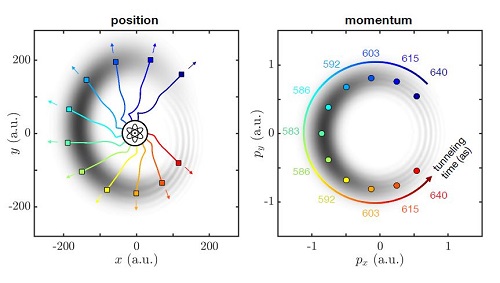Accueil > Séminaires > Année 2024 > Séminaire de Jonathan Dubois (13 février)
Séminaire de Jonathan Dubois (13 février)
Laboratoire de Chimie Physique Matière et Rayonnement - CNRS/Sorbonne Université
par - 14 janvier (modifié le 25 janvier)
Clocking the tunneling time in strong-field ionization
When a quantum particle undergoes tunneling, the time spent under the barrier, referred to as the tunneling time, is subject to several debated questions regarding both its definition and its measurability [1,2]. In particular, the measurement of the tunneling times in the context of strong-field ionization [3] is still controversial [4] and the latest conclusions remain in conflict with the results from so-called Larmor clock experiments [5]. Here, we will show that a photoelectron wavepacket created through tunneling carries information on its own tunneling time, making it an unambiguously measurable quantity in the context of highly non-linear strong-field physics.
For this, we identify a dynamical process, the ‘transversal squeezing’, according to which the longer the time a 3D wavepacket spends ‘under’ a barrier, the narrower its transverse momentum distribution at the tunnel exit. Our approach has been rigorously established analytically within an SFA-like framework and constitutes an alternative theory for the interpretation of ‘attoclock’ experiments [3]. Its practical implementation also uses a circularly polarized laser which, at the atomic scale, creates a tunneling barrier that both oscillates and rotates within the pulse. Therefore, a given photoemission direction is associated with a single barrier configuration. By fully exploiting this mapping and the transversal squeezing, we can thus attribute a given tunneling time to each direction in the photoelectron moment distribution (PMD), in a more comprehensive way than the original attoclock. Using numerical ab initio simulations on H initially in its 1s ground state, we show that a proper analysis of the PMD gives access to orientation-dependent tunneling times lying in the 100 as range, in excellent agreement with the SFA-based predictions. Furthermore, an extension to initial states carrying ring currents (m≠0) demonstrates that electrons counter-rotating with the laser undergo shorter tunneling times than co-rotating ones [6] and provides an additional improvement of the original attoclock.

- Amplitude probability (left panel) at the end of the laser pulse and trajectories (colored lines) guiding wavepackets ionized at different times. Photoelectron momentum distribution (right panel), asymptotic momentum (colored dots) associated with each emission angle and tunneling time.
[1] M. Büttiker & R. Landauer, Phys. Rev. Lett. 49, 1739 (1982)
[2] D. Sokolovski, Phys. Rev. A 52, R5® (1995)
[3] P. Eckle et al., Science 322, 1525 (2008)
[4] U. S. Sainadh et al., J. Phys. Phot. 2, 042002 (2020)
[5] R. Ramos et al., Nature 583, 529 (2020)
[6] J. Dubois et al., Phys. Rev. A (in production)


